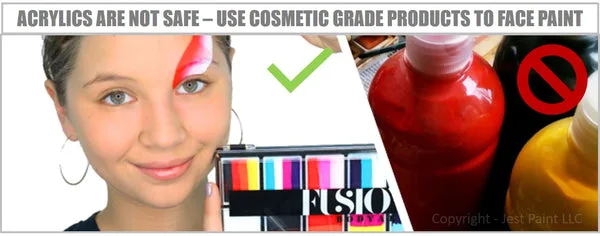To make acrylic paint safe for the skin, the simple answer is that you cannot. Acrylic paint, along with other types of paint such as oil paints and watercolors, are not designed to be used on the body and are therefore not safe.
Acrylic paint does not contain pharmaceutical-grade ingredients and should not be used on the skin. Painting the body with acrylic paint can lead to skin irritations, allergic reactions, and other negative effects. It is best to use paints that are specifically formulated for use on the skin, such as body paints or face paints, which can be easily removed with soap and water.
Table of Contents
Introduction To Acrylic Paint And Skin Safety
Discover how to make acrylic paint safe for the skin with these helpful tips. Although acrylic paint is not designed for skin use, you can ensure safety by avoiding direct contact and washing it off promptly with soap and water.

What Is Acrylic Paint?
Acrylic paint is a type of paint that is known for its fast-drying and versatile nature. It consists of pigments suspended in an acrylic polymer emulsion, which gives it its characteristic creamy texture. Acrylic paint is commonly used by artists, hobbyists, and crafters for various artistic projects due to its vibrant colors and ability to adhere to a wide range of surfaces.
Why Is Acrylic Paint Unsafe For Skin?
Using acrylic paint directly on the skin can be harmful for several reasons. Firstly, acrylic paint contains chemicals and pigments that are not intended for contact with the skin. These chemicals can cause irritation, allergic reactions, and even chemical burns when applied to the skin for a prolonged period. Secondly, acrylic paint dries quickly and forms a plastic-like film on the skin, which can restrict the skin’s ability to breathe and lead to discomfort and potential skin issues.
Myths And Misconceptions About Acrylic Paint
There are myths and misconceptions surrounding the safety of using acrylic paint on the skin. However, it is important to dispel these misconceptions and prioritize skin safety. Some common misconceptions include:
- Myth: Acrylic paint is non-toxic and safe for skin use.
- This is not true. While acrylic paint may be labeled as non-toxic, it is important to note that this designation is based on its intended use as an art material and not for direct contact with the skin.
- Myth: Mixing acrylic paint with other substances will make it safe for skin use.
- This is also untrue. Adding substances like lotions, oils, or even water to acrylic paint will not change its chemical composition and make it safe for skin application.
- Myth: Acrylic paint can be easily removed from the skin with just soap and water.
- Unfortunately, acrylic paint can be difficult to remove from the skin using just soap and water. It may require additional measures such as using specialized paint removers or oils to completely remove the paint.
It is crucial to prioritize skin safety when it comes to any form of body art. Instead of using acrylic paint directly on the skin, opting for body-safe paints specifically designed for skin application is recommended. These paints are formulated with non-toxic and skin-friendly ingredients, ensuring a safe and enjoyable experience for both artists and individuals.

Credit: www.coit.com
Safe Alternatives To Acrylic Paint For Skin
Discover safe alternatives to acrylic paint for the skin with this helpful guide on making acrylic paint safe for the skin. Learn tips and tricks for using non-toxic paints and how to remove them from your skin easily.
Water-based Face Paints
Water-based face paints are a safe alternative to acrylic paint for skin. These paints are specifically formulated to be used on the face and body, making them non-toxic and gentle on the skin. Water-based face paints are easily washable with soap and water, ensuring a hassle-free removal process. They come in a wide range of vibrant colors, allowing you to create stunning designs and elaborate face paint looks. Whether you are a professional face painter or just love experimenting with different makeup looks, water-based face paints are a great option to consider.
Body-safe Paints
When it comes to painting directly on the skin, it is important to choose paints that are specifically labeled as body-safe. These paints are specifically formulated to be hypoallergenic and non-toxic, ensuring that they won’t cause any skin irritation or allergic reactions. Body-safe paints are available in a variety of formulations, including liquid latex, body paint gels, and cream-based paints. They are perfect for creating intricate body art, temporary tattoos, and special effects makeup looks. It is recommended to always check the ingredients list and follow the manufacturer’s instructions for safe and proper use.
Homemade Alternatives
If you prefer a DIY approach or want to avoid store-bought products, there are homemade alternatives to acrylic paint for skin that you can try. One popular option is making your face paint using natural ingredients like cornstarch, food coloring, and a skin-friendly cream or lotion as a base. This allows you to have full control over the ingredients and customize the colors according to your preference. However, it is important to remember that homemade alternatives may not have the same level of longevity or vibrancy as commercial products, so they might be more suitable for short-term use or simple designs. Additionally, always do a patch test on a small area of skin before applying homemade alternatives to ensure that you don’t have any allergic reactions.
How To Make Acrylic Paint Safe For Skin
Acrylic paint is not safe for the skin as it is not designed to be used on the body. It is recommended to avoid using acrylics, tempera, oil paints, spray paint, house paint, or watercolors on the skin.
Using Safe Additives
When it comes to making acrylic paint safe for skin, the use of safe additives is essential. These additives are specifically designed to make the paint more suitable for use on the body. One popular additive is a skin-safe body paint medium, which can be mixed with acrylic paint to create a smoother, more flexible, and less harsh formulation.
Another safe additive is a skin barrier cream or lotion. Applying a thin layer of this cream or lotion on the skin before painting can create a protective barrier and make it easier to remove the paint later on.
It is important to note that not all additives are safe for skin use. Before using any new additive, it is advisable to do thorough research or consult with a professional to ensure its safety.
Testing And Patching
Before applying acrylic paint to a larger area of skin, it is crucial to conduct a patch test to check for any adverse reactions. Choose a small area, such as the inside of the wrist, and apply a small amount of the paint mixture. Leave it on for a few hours or overnight and observe for any signs of redness, irritation, or allergic reactions.
If no adverse reactions occur during the patch test, it is generally safe to proceed with using the acrylic paint on a larger area of the skin.
Proper Removal Techniques
Removing acrylic paint from the skin requires proper techniques to ensure it is done safely and without causing any damage. Here are some recommended removal techniques:
- Gently wash the painted area with mild soap and warm water. Avoid scrubbing too hard, as this can irritate the skin.
- For more stubborn paint, use a gentle oil-based cleanser or makeup remover to dissolve the paint.
- Do not use harsh chemicals or solvents, as they can be too abrasive for the skin.
- After removing the paint, moisturize the skin with a gentle and hydrating lotion or cream to restore moisture and soothe any potential irritation.

Credit: themakinglife.com

Credit: www.bbfrosch.com
Frequently Asked Questions On How To Make Acrylic Paint Safe For Skin
Can You Make Acrylic Paint Skin Safe?
No, acrylic paint is not safe for the skin. It is not designed to be used on the body.
Can I Turn Acrylic Paint Into Face Paint?
No, acrylic paint should not be used as face paint. It is not made with safe, pharmaceutical-grade ingredients and can be harmful to the skin. It is best to use face and body paint that is specifically designed for use on the skin and can be easily removed with soap and water.
How Easy Does Acrylic Paint Come Off Skin?
Acrylic paint is stubborn to remove from the skin and may take time. Use rubbing alcohol or a similar solvent on a cotton ball to remove it. Avoid using acetone. Acrylic paint should not be used on the body since it is not designed to be skin-safe.
Is Acrylic Paint Toxic On Hands?
No, acrylic paint is not safe for hands as many of the pigments used in acrylic paints are toxic. It is not designed to be used on the body and should not come into contact with the skin.
Conclusion
It is important to remember that acrylic paint is not safe for direct application on the skin. While there are non-toxic options available in the market, they are not specifically designed for skin use. It is recommended to use paints specifically formulated for body painting or face painting, as they are made with safe and tested ingredients.
Removing acrylic paint from the skin can also be a challenge, so it’s best to use appropriate and safe products for skin application to ensure the well-being of your skin.
1 thought on “How to Make Acrylic Paint Safe for Skin: Ultimate Guide”